#atlantic chub mackerel
Explore tagged Tumblr posts
Text

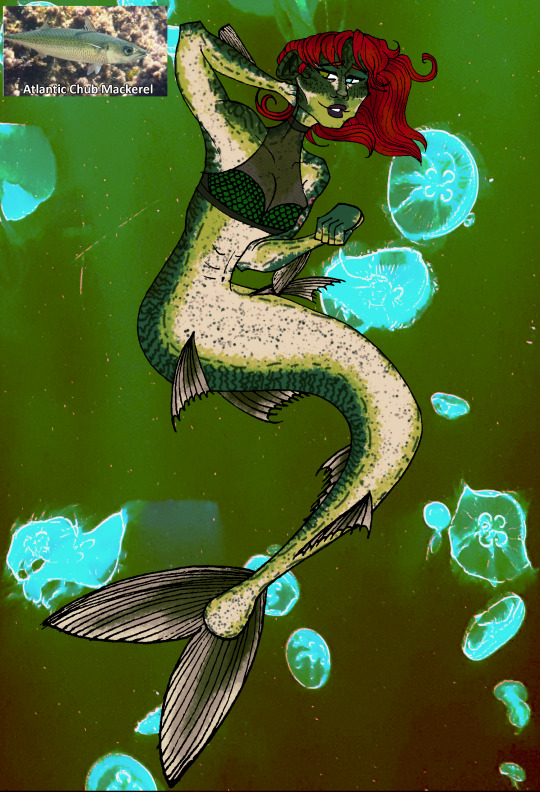
lorelei-super speed mercreature-2013
#ocs#original character#character sheet#character reference#digital art#mermaid#mermaids#mercreatures#atlantic chub mackerel#oceanracers#the dangers#lorelei#my art#another Mind Controlled Villain#but! unlike the rest their Connection is severed prematurely&we See them go back to their normal self after they get bit by a shark which#disrupts trop's control over them#&they run for help to their friend sheala [next post :)))]#they/them btw!
3 notes
·
View notes
Text

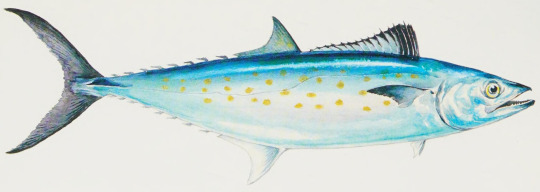
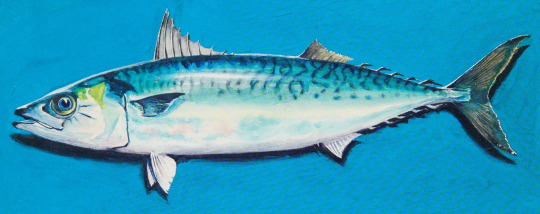
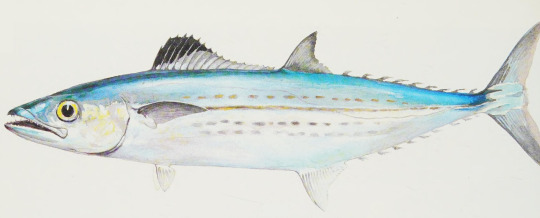
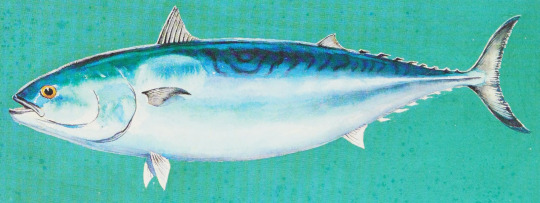
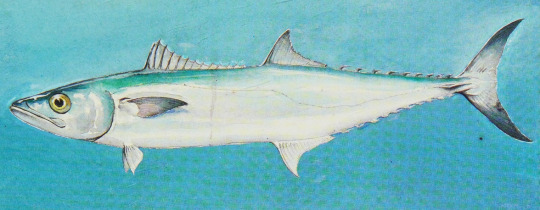
An Artist's Catch: Watercolors by Frank Stick (1884-1966). Edited by David Stick. Published in 1981.
Internet Archive
1.) Atlantic mackerel (Scomber scombrus)
2.) Atlantic Spanish mackerel (Scomberomorus maculatus)
3.) Chub mackerel (Scomber japonicus)
4.) Cero mackerel (Scomberomorus regalis)
5.) Frigate tuna (Auxis thazard)
6.) King mackerel (Scomberomorus cavalla)
#marine life#fish#bony fish#mackerel#atlantic mackerel#atlantic spanish mackerel#chub mackerel#cero mackerel#king mackerel#tunas#frigate tuna#Frank Stick
1K notes
·
View notes
Note
your ask box wanted an ask in it
do you like fish
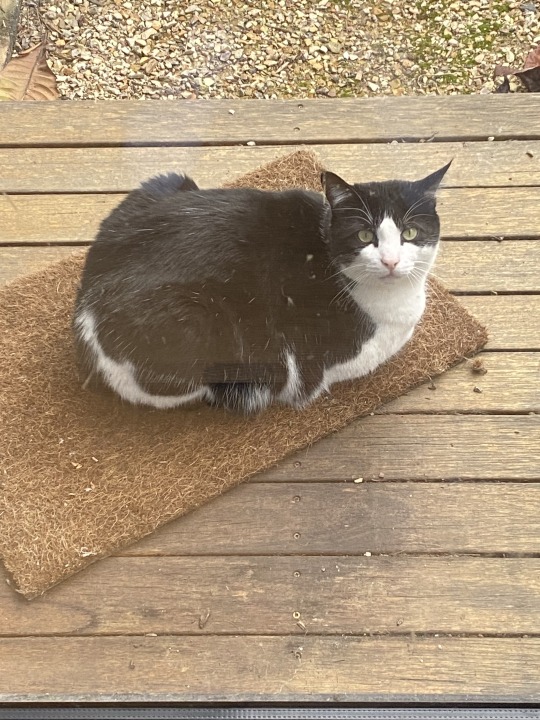
Who doesn't
I like all kinds of fishes
Here is my top 250 fishes
1. Salmon
2. Tuna
3. Cod
4. Trout
5. Bass
6. Snapper
7. Mackerel
8. Halibut
9. Swordfish
10. Sardines
11. Haddock
12. Flounder
13. Mahi-mahi
14. Catfish
15. Perch
16. Tilapia
17. Carp
18. Pike
19. Anchovy
20. Herring
21. Grouper
22. Sole
23. Barracuda
24. Bluefish
25. Redfish
26. Wahoo
27. Pompano
28. Yellowtail
29. Rockfish
30. Bluegill
31. Walleye
32. Whitefish
33. Rainbow trout
34. Lingcod
35. Skate
36. Bluefin tuna
37. Striped bass
38. Marlin
39. Sturgeon
40. Eel
41. Butterfish
42. Wolffish
43. Opah
44. Tilefish
45. Drum
46. Tilapia
47. Gurnard
48. Threadfin
49. Monkfish
50. Opaleye
51. Triggerfish
52. Cutlassfish
53. Pomfret
54. Bullhead
55. Croaker
56. Tautog
57. Sheepshead
58. Wrasse
59. Parrotfish
60. Hogfish
61. Porgy
62. Permit
63. Amberjack
64. Bonito
65. Tilefish
66. Croaker
67. Hogfish
68. Mullet
69. Ribbonfish
70. Drum
71. Saury
72. Tarpon
73. Mullet
74. Bluefish
75. Garfish
76. Wels catfish
77. Gizzard shad
78. Bowfin
79. Stickleback
80. Freshwater drum
81. Sucker
82. Bullhead
83. Sculpin
84. Mooneye
85. Goby
86. Chub
87. Mudminnow
88. Dace
89. Silverside
90. Lamprey
91. Minnow
92. Darter
93. Smelt
94. Sunfish
95. Sturgeon
96. Shad
97. Sablefish
98. Greenland cod
99. Hake
100. Grenadier
101. Cobia
102. Tilefish
103. Pollack
104. Oarfish
105. John Dory
106. Swai
107. Largemouth bass
108. Atlantic cod
109. Kingfish
110. Wolffish
111. Skate
112. Arctic char
113. Goby
114. Lumpfish
115. Gourami
116. Gar
117. Codling
118. Butterfish
119. Blenny
120. Wrasse
121. Roach
122. Rainbow smelt
123. Peacock bass
124. Pompano
125. Pikeperch
126. Minnow
127. Leatherjacket
128. Jackfish
129. Halibut
130. Gurnard
131. Grouper
132. Grunion
133. Grunt
134. Greenling
135. Grayling
136. Gray mullet
137. Grass carp
138. Goldfish
139. Golden perch
140. Ghost carp
141. Garfish
142. Fusilier
143. Flathead
144. Filefish
145. Electric eel
146. Dogfish
147. Doctor fish
148. Dory
149. Dolphin fish
150. Dolly Varden
151. Dogfish
152. Drum
153. Dusky grouper
154. Dunkleosteus
155. Dusky shark
156. Duckbill
157. Driftfish
158. Dragonet
159. Dorado
160. Donzella
161. Dolphinfish
162. Dogfish
163. Dogtooth tuna
164. Dogfish
165. Dory
166. Dusky grouper
167. Dunkleosteus
168. Dusky shark
169. Duckbill
170. Driftfish
171. Dragonet
172. Dorado
173. Donzella
174. Dolphinfish
175. Dogfish
176. Dogtooth tuna
177. Eel
178. Emperor
179. Eleuth
180. Elephantfish
181. Eelpout
182. Elver
183. Escolar
184. European flounder
185. European seabass
186. European perch
187. Flathead grey mullet
188. European eel
189. Eagle ray
190. Eastern mosquitofish
191. Eastern little tuna
192. Eastern mudminnow
193. European minnow
194. European sprat
195. Emperor tetra
196. Emperor angelfish
197. Emperor bream
198. Emporer red snapper
199. Emperor sole
200. Emperor shrimp
201. Emperor scorpionfish
202. Escolar
203. False trevally
204. False cat shark
205. False scad
206. False trevally
207. False cat shark
208. False scad
209. Fantail darter
210. Fathead minnow
211. Fathead sculpin
212. Featherfin squeaker
213. Fingerfish
214. Fire goby
215. Firefish
216. Flabby whalefish
217. Flagfish
218. Flat loach
219. Flathead catfish
220. Flathead grey mullet
221. Flathead
222. Flathead sole
223. Flounder
224. Flying gurnard
225. Flying fish
226. Freshwater butterflyfish
227. Freshwater drum
228. Freshwater eel
229. Freshwater garfish
230. Freshwater hatchetfish
231. Freshwater shark
232. Frigate mackerel
233. Frill shark
234. Frostfish
235. Fuji fish
236. Finescale triggerfish
237. Four-eyed fish
238. Fringe-scale sardine
239. Fullscale sculpin
240. Fulmar
241. Fusilier
242. Galjoen fish
243. Gaper
244. Garibaldi
245. Garpike
246. Ghost fish
247. Ghost flathead
248. Giant catfish
249. Giant danio
250. Giant gouram
What is your favorite fish ? :3
6 notes
·
View notes
Text
Kolyoz Balığı Nedir? Besin Değerleri ve Faydaları Nelerdir?
Kolyoz Balığı Nedir? Besin Değerleri ve Faydaları Nelerdir? ✅
Kolyoz veya Kolyos balığı (Scomber Japonicus), uskumrugiller familyasına ait göçmen bir balık türüdür. Uskumrugiller familyasından olan Kolyoz sıklıkla Uskumru balığı ile karıştırılmaktadır. Türkiye’de batı Karadeniz, Akdeniz, Ege ve Marmara denizinde yaşarlar. İngilizce adı ise Chub Mackerel’dır. Kolyoz Balığı Hakkında Bilgiler Uskumrugiller familyasından olan kolyoz, vücut yapısı, zengin…

View On WordPress
#Atlantic Mackerel#Chub Mackerel#Çiroz#Kolyos#Kolyos Balığı#Kolyos Balığı Hakkında Bilgiler#Kolyoz#Kolyoz Balığı#Kolyoz Balığı Nedir#Pasific Mackerel
0 notes
Photo

The full book title contains 3777 words and reads as follows: 'The historical development of the Heart i.e. from its formation from Annelida: Clam worm, Seamouse, Lugworm, Megascolex, Tubifex, Pheretima, Freshwater leech, marine leech, land leech. Arthropoda: Ladybird, Krill, Rock Barnacle, Root-headed Barnacle, Copepod, Silverfish, Cairns birdwing, Silver - spotted skipper, Scutigera, Cray fish, Large white, Andonis blue, Camberwell beauty, Tiger swallowtail, Regent skipper, Black – veined white, Green – underside blue, Blue Morpho, Apollo, Guava skipper, Cleopatra, Large copper, Millipede, Orb spider, Black widow spider, Giant crab spider, Wolf spider, Bird – eating spider, Tenebrionid beetle, Green Tiger beetle, African goliath beetle, Scolopendra, Diving beetle, African ground beetle, New guinea weevil, Barnacle, Lobster, Shrimp, Woodlice, Mite, Prawn, Housefly, Butterfly, Monarch butterfly, Peacock butterfly, Honey bee, Fairy shrimp, Horsehoe crab, Tick, Bluebootle, Froghopper, Yellow crazy ant, Water flea, Sea spider, Fiddler crab, Shiny spider crab, Hermit crab, Sail swallowtail, Red admiral, Morpho butterfly, Desert locust, Stephens island weta, Speckled bush cricket, Mole cricket, Dung – beetle, Euthalia ynipardus, Small blues, Termite, Hornet, Mosquito, Garden spider, Tarantula, Desert hairy scorpion, Emperor dragon – fly, Moth, Centipede, Wood ant, Stag beetle, Indian red admiral, Blue admiral, Harvestman, Hoverfly, Shield bug, Assassin bug, Cicada, Coreid bug, Rose aphid, Water – boatman, Wasp, June bug, Large tortoiseshell, Frog beetle, Mexican red – legged tarantula, Paintedlady, Sydney funnelweb spider, Small tortoiseshell, Mountain bumble bee, Trapdoor spider, Jumping spider, Daddy longlegs spider, Orchind bee, Asian carpenter bee, Parasitic bee, House spider, Giant longhorn beetle, Flea, Bedbug Beetle, Cockroach, Scorpion, Spider, Ant, Gnats, Grasshopper, Silver fish, Crab, Great green bush cricket, Elephant hawk – moth. Mollusca: Neomenia, Chaetoderma, Chiton, Lepidopleurus, Apple snail, Sea hare, Sea lemon, Dentalium, Freshwater mussel, Marine mussel, Pearl oyster, Cuttlefish, Giant squid, Chambered fish, Devilfish. Fishes or Pisces: African glass catfish, African lungfish, Aholehole, Airbreathing catfish, Alaska blackfish, Albacore, Alewife, Alfonsino, Algae eater, Alligatorfish, Alligator gar, Amberjack - Seriola dumerili, American sole, Amur pike, Anchovy, Anemonefish, Angelfish, Angler, Angler catfish, Anglerfish, Antarctic cod, Antarctic icefish, Antenna codlet, Arapaima, Archerfish, Arctic char, Armored gurnard, Armored searobin, Armorhead, Armorhead catfish, Armoured catfish, Arowana, Arrowtooth eel, Asian carps, Asiatic glassfish, Atka mackerel, Atlantic Bonito (Sarda sarda), Atlantic cod, Atlantic herring, Atlantic salmon, Atlantic Sharpnose Shark - Rhizoprioltodon terraenovae, Atlantic saury, Atlantic silverside, Australasian salmon, Australian grayling, Australian herring, Australian lungfish, Australian prowfish, Ayu, Baikal oilfish, Bala shark, Ballan wrasse, Bamboo shark, Banded killifish, Bandfish, Banjo, Bangus, Banjo catfish, Bank Sea Bass, Barb, Barbel, Barbeled dragonfish, Barbeled houndshark, Barbel-less catfish, Barfish, Barracuda, Barracudina, Barramundi, Barred danio, Barreleye, Basking shark, Bass, Basslet, Batfish, Bat ray, Beachsalmon, Beaked salmon, Beaked sandfish, Beardfish, Beluga sturgeon, Bengal danio, Betta, Bichir, Bicolor goat fish, Bigeye, , Bighead carp, Bigmouth buffalo, Bigscale, Billfish, Bitterling, Black angelfish, Black bass, Black dragonfish, Blackchin, Blackfin Tuna - Thunnus atlanticus, Blackfish, Black neon tetra, Blacktip reef shark, Black mackerel, Black scalyfin, Black sea bass, Black scabbardfish, Black swallower, Black tetra, Black triggerfish, Bank Sea Bass aka Yellow Sea Bass - Centropristis ocyurus, Bleak, Blenny, Blind goby, Blind shark, Blobfish, Blueline Tilefish, Blowfish, Blue catfish, Blue danio, Blue-redstripe danio, Blueline Tilefish , Blue eye, Bluefin tuna, Bluefish, Bluegill, Blue gourami, Blue shark, Blue triggerfish, Blue whiting, Bluntnose knifefish, Bluntnose minnow, Boafish, Boarfish, Bobtail snipe eel, Bocaccio, Boga, Bombay duck, Bonefish, Bonito, Bonnetmouth, Bonytail chub, Bronze corydoras, Bonytongue, Bowfin, Boxfish, Bramble shark, Bream, Brill, Bristlemouth, Bristlenose catfish, Broadband dogfish, Brook lamprey, Brook trout, Brotula, Brown trout, Buffalo fish, Bullhead, Bullhead shark, Bull shark, Bull trout, Burbot, Bumblebee goby, Buri, Burma danio, Burrowing goby, Butterfish, Butterfly ray, Butterflyfish, California flyingfish, California halibut, Canary rockfish, Candiru, Candlefish, Capelin, Cardinalfish, Cardinal tetra, Carp, Carpetshark, Carpsucker, Catalufa, Catfish, Catla, Cat shark, Cavefish, Celebes rainbowfish, Central mudminnow, Chain pickerel, Channel bass, Channel catfish, Char, Cherry salmon, Chimaera, Chinook salmon, Cherubfish, Chub, Chubsucker, Chum salmon, Cichlid, Cisco, Climbing catfish, Climbing gourami, Climbing perch, Clingfish, Clownfish, Clown loach, Clown triggerfish, Cobbler, Cobia, Cod, Codlet, Codling, Coelacanth, Coffinfish, Coho salmon, Coley, Collared carpetshark, Collared dogfish, Colorado squawfish, Combfish, Combtail gourami, Common carp, Common tunny, Conger eel, Convict blenny, Convict cichlid, Cookie-cutter shark, Coolie loach, Cornetfish, Cowfish, Cownose ray, Cow shark, Crappie, Creek chub, Crestfish, Crevice kelpfish, Croaker, Crocodile icefish, Crocodile shark, Crucian carp, Cuckoo wrasse, Cusk, Cusk-eel, Cutlassfish, Cutthroat eel, Cutthroat trout, Dab, Dace, Desert pupfish, Devario, Devil ray, Dhufish, Discus, Diver: New Zealand sand diver or long-finned sand diver, Dogfish, Dogfish shark, Dogteeth tetra, Dojo loach, Dolly Varden trout, Dolphin fish - Corypaena hippurus, Dorab, Dorado, Dory, Dottyback, Dragonet, Dragonfish, Dragon goby, Driftfish, Driftwood catfish, Drum, Duckbill, Duckbill eel, Dusky grouper, Dusky Shark - Carcharhinus obscurus, Dwarf gourami, Dwarf loach, Eagle ray, Earthworm eel, Eel, Eel cod, Eel-goby, Eelpout, Eeltail catfish, Elasmobranch, Electric catfish, Electric eel, Electric knifefish, Electric ray, Elephant fish, Elephantnose fish, Elver, Ember parrotfish, Emerald catfish, Emperor angelfish, Emperor bream, Escolar, Eucla cod, Eulachon, European chub, European eel, European flounder, European minnow, European perch, False brotula, False cat shark, False moray, Fangtooth, Fathead sculpin, Featherback, Fierasfer, Fire goby, Filefish, Finback cat shark, Fingerfish, Firefish, Flabby whale fish, Flagblenny, Flagfin, Flagfish, Flagtail, Flashlight fish, Flatfish, Flathead, Flathead catfish, Flier, Flounder, Flying gurnard, Flying fish, Footballfish, Forehead brooder, Four-eyed fish, French angelfish, Freshwater eel, Freshwater hatchetfish, Freshwater shark, Frigate mackerel, Frilled shark, Frogfish, Frogmouth catfish, Fusilier fish, Galjoen fis, Ganges shark, Geel, Garibaldi, Garpike, Ghost fish, Ghost flathead, Ghost knifefish, Ghost pipefish, Ghost shark, Ghoul, Giant danio, Giant gourami, Giant sea bass, Gibberfish, Gila trout, Gizzard shad, Glass catfish, Glassfish, Glass knifefish, Glowlight danio, Goatfish, Goblin shark, Goby, Golden dojo, Golden loach, Golden shiner, Golden trout, Goldeye, Goldfish, Gombessa, Goosefish, Gopher rockfish, Gourami, Grass carp, Graveldiver, Grayling, Gray mullet, Gray reef shark, Great white shark, Green swordtail, Greeneye, Greenling, Grenadier, Green spotted puffer, Ground shark, Grouper, Grunion, Grunt, Grunter, Grunt sculpin, Gudgeon, Guitarfish, Gulf menhaden, Gulper eel, Gulper, Gunnel, Guppy, Gurnard, Haddock, Hagfish, Hairtail, Hake, Halfbeak, Halfmoon, Halibut, Halosaur, Hamlet, Hammerhead shark, Hammerjaw, Handfish, Hardhead catfish, Harelip sucker, Hatchetfish, Hawkfish, Herring, Herring smelt, Hickory Shad, Horn shark, Horsefish, Houndshark, Huchen, Humuhumunukunukuapua'a, Hussar, Icefish, Ide, Ilisha, Inanga, Inconnu, Jack, Jackfish, Jack Dempsey, Japanese eel, Javelin, Jawfish, Jellynose fish, Jewelfish, Jewel tetra, Jewfish, John Dory, Kafue pike, Kahawai, Kaluga, Kanyu, Kelp perch, Kelpfish, Killifish, King of the herrings, Kingfish, King-of-the-salmon, Kissing gourami, Knifefish, Knifejaw, Koi, Kokanee, Kokopu, Kuhli loach, Labyrinth fish, Ladyfish, Lake chub, Lake trout, Lake whitefish, Lampfish, Lamprey, Lanternfish, Largemouth bass, Leaffish, Lefteye flounder, Lemon shark, Lemon sole, Lemon tetra, Lenok, Leopard danio, Lightfish, Limia, Lined sole, Ling, Ling cod, Lionfish, Livebearer, Lizardfish, Loach, Loach catfish, Loach goby, Loach minnow, Longfin, Longfin dragonfish, Longfin escolar, Longfin smelt, Long-finned char, Long-finned pike, Longjaw mudsucker, Longneck eel, Longnose chimaera, Longnose dace, Longnose lancetfish, Longnose sucker, Longnose whiptail catfish, Long-whiskered catfish, Loosejaw, Lost River sucker, Louvar, Loweye catfish, Luderick, Luminous hake, Lumpsucker, Lungfish, Mackerel, Mackerel shark, Madtom, Mahi-mahi, Mahseer, Mail-cheeked fish, Mako shark, Mandarinfish, Masu salmon, Medaka, Medusafish, Megamouth shark, Menhaden, Merluccid hake, Mexican golden trout, Midshipman fish, Milkfish,, Minnow, Minnow of the deep, Modoc sucker, Mojarra, Mola, Monkeyface prickleback, Monkfish, Mooneye, Moonfish, Moorish idol, Mora, Moray eel, Morid cod, Morwong, Moses sole, Mosquitofish, Mouthbrooder, Mozambique tilapia, Mrigal, Mud catfish (Mud cat), Mudfish, Mudminnow, Mud minnow, Mudskipper, Mudsucker, Mullet, Mummichog, Murray cod, Muskellunge, Mustache triggerfish, Mustard eel, Naked-back knifefish, Nase, Needlefish, Neon tetra, New World rivuline, New Zealand smelt, Nibble fish, Noodlefish, North American darter, North American freshwater catfish, North Pacific daggertooth, Northern anchovy, Northern clingfish, Northern lampfish, Northern pike, Northern sea robin, Northern squawfish, Northern stargazer, Notothen, Nurseryfish, Nurse shark, Oarfish, Ocean perch, Ocean sunfish, Oceanic whitetip shark, Oilfish, Oldwife, Old World knifefish, Olive flounder, Opah, Opaleye, Orange roughy, Orangespine unicorn fish, Orangestriped triggerfish, Orbicular batfish, Orbicular velvetfish, Oregon chub, Orfe, Oriental loach, Oscar, Owens pupfish, Pacific albacore, Pacific cod, Pacific hake, Pacific herring, Pacific lamprey, Pacific salmo, Pacific saury, Pacific trout, Pacific viperfish, Paddlefish, Pancake batfish, Panga, Paradise fish, Parasitic catfish, Parore, Parrotfish, Peacock flounder, Peamouth, Pearleye, Pearlfish, Pearl danio, Pearl perch, Pelagic cod, Pelican eel, Pelican gulper, Pencil catfish, Pencilfish, Pencilsmelt, Peppered corydoras, Perch, Peters' elephantnose fish, Pickerel, Pigfish, Pike conger, Pike eel, Pike, Pikeblenny, Pikeperch, Pilchard, Pilot fish, Pineapplefish, Pineconefish, Pink salmon, Píntano, Pipefish, Piranha, Pirarucu, Pirate perch, Plaice, Platy, Platyfish, Pleco, Plownose chimaera, Poacher, Pollock, Pomfret, Pompano dolphinfish, Ponyfish, Popeye catalufa, Porbeagle shark, Porcupinefish, Porgy, Port Jackson shark, Powen, Prickleback, Pricklefish, Prickly shark, Prowfish, Pufferfish, Pumpkinseed, Pupfish, Pygmy sunfish, Queen danio, Queen parrotfish, Queen triggerfish, Quillback, Quillfish, Rabbitfish, Raccoon butterfly fish, Ragfish, Rainbow trout, Rainbowfish, Rasbora, Ratfish, Rattail, Ray, Razorback sucker, Razorfish, Red Grouper, Red salmon, Red snapper, Redfin perch, Redfish, Redhorse sucker, Redlip blenny, Redmouth whalefish, Redtooth triggerfish, Red velvetfish, Red whalefish, Reedfish, Reef triggerfish, Remora, Requiem shark, Ribbon eel, Ribbon sawtail fish, Ribbonfish, Rice eel, Ricefish, Ridgehead, Riffle dace, Righteye flounder, Rio Grande perch, River loach, River shark, River stingray, Rivuline, Roach, Roanoke bass, Rock bass, Rock beauty, Rock cod, Rocket danio, Rockfish, Rockling, Rockweed gunnel, Rohu, Ronquil, Roosterfish, Ropefish, Rough scad, Rough sculpin, Roughy, Roundhead, Round herring, Round stingray, Round whitefish, Rudd, Rudderfish, Ruffe, Russian sturgeon, Sábalo, Sabertooth, Saber-toothed blenny, Sabertooth fish, Sablefish, Sacramento blackfish, Sacramento splittail, Sailfin silverside, Sailfish, Salamanderfish, Salmon, Salmon shark, Sandbar shark, Sandburrower, Sand dab, Sand diver, Sand eel, Sandfish, Sand goby, Sand knifefish, Sand lance, Sandperch, Sandroller, Sand stargazer, Sand tiger, Sand tilefish, Sandbar Shark - Carchathinus plumbeus, Sarcastic fringehead, Sardine, Sargassum fish, Sauger, Saury, Sawfishm, Saw shark, Sawtooth eel, Scabbard fish, Scaly dragonfish, Scat, Scissortail rasbora, Scorpionfish, Sculpin, Scup, Sea bass, Sea bream, Sea catfish, Sea chub, Sea devil, Sea dragon, Sea lamprey, Sea raven, Sea snail, Sea toad, Seahorse, Seamoth, Searobin, Sevan trout, Sergeant major, Shad, Shark, Sharksucker, Sharpnose puffer, Sheatfish, Sheepshead, Sheepshead minnow, Shiner, Shortnose chimaera, Shortnose sucker, Shovelnose sturgeon, Shrimpfish, Siamese fighting fish, Sillago, Silver carp, Silver dollar, Silver dory, Silver hake, Silverside, Silvertip tetra, Sind danio, Sixgill ray, Sixgill shark, Skate, Skilfish, Skipjack tuna, Slender mola, Slender snipe eel, Sleeper, Sleeper shark, Slickhead, Slimehead, Slimy mackerel, Slimy sculpin, Slipmouth, Smalleye squaretail, Smalltooth sawfish, Smelt, Smelt-whiting, Smooth dogfish, Snailfish, Snake eel, Snakehead, Snake mackerel, Snapper, Snipe eel, Snipefish, Snoek, Snook, Snubnose eel, Snubnose parasitic eel, Sockeye salmon, Soldierfish, Sole, South American darter, South American lungfish, Southern Dolly Varden, Southern flounder, Southern hake, Southern sandfish, Southern smelt, Spadefish, Spaghetti eel, Spanish mackerel, Spearfish, Speckled trout, Spiderfish, Spikefish, Spinefoot, Spiny basslet, Spiny dogfish, Spiny dwarf catfish, Spiny eel, Spinyfin, Splitfin, Spookfish, Spotted climbing perch, Spotted danio, Spottail Pinfish - Diplodus holbrooki, Sprat, Springfish, Squarehead catfish, Squaretail, Squawfish, Squeaker, Squirrelfish, Staghorn sculpin, Stargazer, Starry flounder, Steelhead, Stickleback, Stingfish, Stingray, Stonecat, Stonefish, Stoneroller minnow, Stream catfish, Striped bass, Striped burrfish, Sturgeon, Sucker, Suckermouth armored catfish, Summer flounder, Sundaland noodlefish,Sunfish, Surf sardine, Surfperch, Surgeonfish, Swallower, Swamp-eel, Swampfish, Sweeper, Swordfish, Swordtail, Tadpole cod, Tadpole fish, Tailor, Taimen, Tang, Tapetail, Tarpon, Tarwhine, Telescopefish, Temperate bass, Temperate perch, Tenpounder, Tenuis, Tetra, Thorny catfish, Thornfish, Threadfin, Threadfin bream, Thread-tail, Three spot gourami, Threespine stickleback, Three-toothed puffer, Thresher shark, Tidewater goby, Tiger barb, Tigerperch, Tiger shark, Tiger shovelnose catfish, Tilapia, Tilefish, Titan triggerfish, Toadfish, Tommy ruff, Tompot blenny, Tonguefish, Tope, Topminnow, Torpedo, Torrent catfish, Torrent fish, Trahira, Treefish, Trevally, Triggerfish, Triplefin blenny, Triplespine, Tripletail, Tripod fish, Trout, Trout cod, Trout-perch, Trumpeter, Trumpetfish, Trunkfish, Tubeblenny, Tube-eye, Tube-snout, Tubeshoulder, Tui chub, Tuna, Turbot, Two spotted goby, Uaru, Unicorn fish, Upside-down catfish, Vanjaram, Velvet belly lanternshark, Velvet catfish, Velvetfish, Vermillion Snapper - Rhomboplites aurorubens, Vimba, Viperfish, Wahoo, Walking catfish, Wallago, Walleye, Walleye Pollock, Walu, Warmouth, Warty angler, Waryfish, Waspfish, Weasel shark, Weatherfish, Weever, Weeverfish, Wels catfish, Whale catfish, Whalefish, Whale shark, Whiff, Whitebait, White croaker, Whitefish, White marlin, White shark, Whitetip reef shark, Whiting, Wobbegong, Wolf-eel, Wolffish, Wolf-herring, Worm eel, Wormfish, Wrasse, Wrymouth, X-ray fish, Yellowback fusilier, Yellowbanded perch, Yellow bass, Yellowedge grouper (Hyporthodus flavolimbatus), Yellow-edged moray, Yellow-eye mullet, Yellowhead jawfish, Yellowfin croaker, Yellowfin cutthroat trout, Yellowfin grouper, Yellowfin Tuna - Thunnus albacares, Yellowfin pike, Yellowfin surgeonfish, Yellowfin tuna, Yellowmargin triggerfish, Yellow moray, Yellow perch, Yellowtail, Yellowtail amberjack, Yellowtail barracuda, Yellowtail clownfish, Yellowtail horse mackerel, Yellowtail kingfish, Yellowtail snapper, Yellow tang, Yellow weaver, Yellowtail catfish, Zander, Zebra bullhead shark, Zebra danio, Zebrafish, Zebra lionfish, Zebra loach, Zebra oto, Zebra pleco, Zebra shark, Zebra tilapia, Zebra turkeyfish, Ziege, Zingel. Amphibians: Frogs and Toads, Painted frogs, Disc tongued frogs, Fire Belly toads, Litter frogs, European Spadefoot toads, Parsley frogs, Tongueless frogs, Clawed frogs, Mexican Burrowing Toad, American spadefoot toads, Screeching frogs, True toads, Glass Frogs, Poison dart frogs, Ghost frogs, Shovelnose frogs, Tree frogs, Sedge frogs, Southern frogs, Narrow-mouthed frogs, Australian ground frogs, True frogs, Moss frogs, Seychelles frog, Giant Salamanders, Asiatic Salamanders, Mole Salamanders, Pacific giant salamanders, Amphiumas, Lungless salamanders, Mudpuppies and Waterdogs, Torrent salamanders, True salamanders and Newts, Sirens, Common caecilians, Fish caecilians, Beaked caecilians. Reptiles: Turtles, common snapping turtles and alligator snapping turtle, pond turtles and box turtles, tortoises, Asian river turtles and allies, pignose turtles, softshell turtles, river turtles, mud turtles, sea turtles, leatherback turtles, tuataras, scaled reptiles, agamas, chameleons, casquehead lizard, iguanas, Madagascar iguanids, collared and leopard lizards, horned lizards, anoles, wood lizards, Neotropical ground lizards, geckos, legless lizards, blind lizards, spinytail Lizards, plated lizards, spectacled lizards, whiptails and tegus, Lacertids, skinks, night lizards, glass lizards, American legless lizards, knob-scaled lizards, gila monsters, earless Monitor lizards, monitor lizards, worm Lizards, shorthead Worm Lizards, two-legged Worm Lizards, snakes, wart snakes, false coral snakes, dwarf pipe snakes, African burrowing asps, stiletto snakes, boas, anacondas, Old World sand boas, Mauritius snakes, Colubrids, typical snakes, Asian pipe snakes, cobras, coral snakes, mambas, sea snakes, Mexican pythons, pythons, dwarf boas, pipe snakes, shield-tailed snakes, vipers, pitvipers, Fae's viper, night adders, pitvipers, rattlesnakes, true vipers, sunbeam snakes, blind snakes, primitive blind snakes, slender blind snakes, thread snakes, blind snakes, typical blind snakes, Crocodiles, alligators, garials. Aves: Ostrich, rheas, cassowaries and emu, kiwis, elephant birds, upland moas, great moas, lesser moas, Tinamous, Australian brush turkey,megapodes, chachalacas, curassows, and guans, Guineafowl, pheasants and allies, New World quail, pheasants and relatives, mihirungs, screamers, magpie-goose, ducks, geese, and swans, grebes, swimming flamingos, flamingos, pigeons and doves, sandgrouse, mesites, Tawny frogmouth, Nightjars, oilbird, potoos, frogmouths, owlet-nightjars, treeswifts, swifts, hummingbird, cuckoos and relatives, turacos and relatives, bustards, hoatzin, cranes and allies, cranes, limpkin, trumpeters, rails and allies, adzebills, finfoots, flufftails, rails and relatives, thick-knees and allies, thick-knees and relatives, sheathbills, Magellanic plover, plover-like waders, golden plovers, ibisbill, oystercatchers, plovers and lapwings, jacana-like waders, painted snipes, Egyptian plover, jacanas, seedsnipes, plains-wanderer, sandpipers and relatives, buttonquail, gulls and allies, coursers and pratincoles, crab-plover, skuas and jaegers, auks and puffins, gulls, skimmers and terns, sunbittern, tropicbirds, penguins, albatrosses, austral storm petrels, northern storm petrels, petrels and relatives, White stork, storks, frigatebirds, boobies and gannets, darters, cormorants and shags, ibises and spoonbills, hamerkop, shoebill, pelicans, herons and relatives, New World vultures, secretarybird, osprey, hawks, eagles, buzzards, harriers, kites and Old World vultures, barn owls, true owls, mousebirds, cuckooroller, trogons and quetzals, hornbills, hoopoe, woodhoopoes, bee-eater, rollers, ground rollers, todies, motmots, Kingfisher, jacamars, puffbirds, African barbets, Asian barbets, toucans, toucan barbets, American barbets, woodpeckers, honeyguides, seriemas, falcons and relatives, kakapo, kea and kakas, cockatoos, African and American parrots, Australasian parrots, Pesquet's parrot, vasa parrots, Pitta cyanea, Lyrebird, New Zealand wrens, suboscines, Old World suboscines, sapayoa, Calyptomenid broadbills, pittas, broadbills, asities, New World suboscines, bronchophones, manakins, cotingas, sharpbills, royal flycatchers and allies, becards and tityras, spadebills, many-colored rush tyrants, mionectine flycatchers, tyrant flycatchers, tracheophones, crescent-chests, gnateaters, antbirds, antpittas, ground antbirds, ovenbirds, oscines, scrub-birds, lyrebirds, bowerbirds, Australasian treecreepers, Australasian wrens, bristlebirds, gerygones and allies, honeyeaters and relatives, Australasian babblers, logrunners, quail-thrushes and jewel-babblers, cuckoo-shrikes, whitehead and allies, sittellas, wattled ploughbills, whipbirds and quail-thrushes, Australo-Papuan bellbirds, crested shriketits, painted berrypeckers, vireos and relatives, whistlers and relatives, Old World orioles, Boatbills, woodswallows and butcherbirds, mottled berryhunter, ioras, bristlehead, bushshrikes and relatives, wattle-eyes and batises, vangas , fantails, silktail, drongo fantail, drongos, blue-capped ifrits, Australian mudnesters, birds-of-paradise, monarch flycatchers, shrikes, jays and crows, berrypeckers, satinbirds, Australasian robins, stitchbird, wattlebirds, rockfowl, rock-jumpers, rail-babbler, fairy warblers, hyliotas, penduline tits, chickadees and true tits, Nicators, bearded reedling, larks, African warblers, cisticolas and relatives, marsh warblers, pygmy wren-babblers, grass warblers, Malagasy warblers, swallows and martins, bulbuls, leaf warblers, bush warblers , Bushtits, true warblers, parrotbills, fulvettas, white-eyes, babblers and relatives, fulvettas, ground babblers, laughing thrushes, kinglets, spotted wren-babblers, Hawaiian honeyeaters, silky-flycatchers, waxwings, Palmchat, hypocolius, wallcreeper, nuthatches, treecreepers, wrens, gnatcatchers, dippers, thrushes and relatives, flycatchers and relatives, oxpeckers, mockingbirds and thrashers, starlings and mynas , sugarbirds, dapplethroat and allies, flowerpeckers, sunbirds, fairy-bluebirds, leafbirds, olive warbler, accentors, pink-tailed bunting, weavers and relatives, whydahs and indigobirds, weaver finches, Old World sparrows, wagtails and pipits, finches and relatives, longspurs, snow buntings, rosy thrush-tanagers, Old World buntings and New World sparrows, American sparrows, palm-tanager and allies, New World blackbirds and New World orioles, Cuban warblers, wood warblers, cardinals, grosbeaks, and New World buntings, tanagers and relatives. MAMMALS: Rat, Bat, Horse, Standardbred, Throughbred, Saddlebred, Arab, Palomino, Australian stock, Appaloosa, Barb, Lippizaner, Mustang, American Shetland, Falabella, Percheron, Shire, Mule, Bullock, Setter, Oxen, Camel, Tiger, Lion, Hyaenas, Leopard, Bear, Cat, Dog, Sheep, Goat, Cow, Cob, Pig, Chamois, Bulldog, Borzoi, Loris, Longspur, Harvest mouse, Spiny – ant eater, Duck – billed platypus, Elephant, Rhinoceros, Tonkinese, Ragdoll, Margay, Tapir, Seal, Sea lion, Walrus, Dolphin, Bactrian camel, Arabian camel, Bushbaby, Burmese cat, Whale, Porpoise, Aardvark, Ape, Monkey, Gorilla, Chimpanzee, Flying Lemur, Hare, Pika, Macaque, Rabbit, Colobus, Antelope, Caribou, Cattle, Deer, Grizzly bear, Hyrax, Armadillo, Porcupine, Hedgehog, Arctic hare, Mole, Shrew, Beaver, Asian black bear, Polar bear, Sloth bear, Spectacled bear, Mouse, Squirrel, Dugong, Moose, Fallow deer, Reindeer, Red deer, Manatee, Egyptian Mau, Scottish fold, Himalayan, Birman, Red squirrel, Hippopotamus, Weasel, Whale, Wither, Blue whale, Sperm whale, Killer whale, Wallaby, Beluga, Baird’s beaked whale, Grey whale, Bryde’s whale, Pygmy right whale, Southern right whale, Seal, Ape, Indri, Aye – aye, Alaskan Malamute, Dobermann, Beagle, Kinkajou, Afgan Hound, Rough Collie, Cardigan Welsh Corgi, Sheepdog, Pointer, Poddle, Weimaraner, Bloodhound, Zebra, Giraffe, Yak, Arctic fox, Polecat, Golden Retriever, Kerry Blue, Prairie dog, Airedale, German spitz, Pekingese, Otter, Shih Tzu, Proboscis monkey, Orang – utan, Red Howler monkey, Spider monkey, Sloth, Koala, Pangolin, Mustelid, Mongoose, Guinea pig, Malayan Porcupine, Naked Mole rat, Capybara, Pallid Gerbil, Brown rat, Somali, Ocicat, Balinese, Bengal, Cymric, Chartreux, Devon Rex, Turkish Angora, Russian Blue, Yellow – necked woodmouse, Hamster, Grey squirrel, Chipmunk, Fox, Blue Longhair, Chinese Pangolin, Blue – cream shorthair, Tortoiseshell and white shorthair, Brown spotted shorthair, Red and white Japanese bobtail, Javanese, Red Persian Longhair, Brown classic tabby maine coon, Lilac angora, Seal point Siamese, Brown and white sphinx, Red classic tabby manx, Vampire bat, Proboscis bat, Franquet’s fruit bat, Bengal Tiger, Horseshoe bat, Noctule bat, Funnel - eared bat, Blue exotic, Foreign lilac oriental shorthair, Boxer, Bay, Cream point colour pointed british shorthair, Abyssinian, Cinnamon silver Cornish rex, Wolverine, Skunk, Human being, Pine marten, Stoat, Chocolate point longhair, Husky, Ant eater, Kangaroo, Gray Mouse Lemur, Musk oxen, Raccoon dogrie, Pasnda, Bouto, Pembroke Welsh corgi, Whippet, Whisker, Indus river dolphin, Franciscana, Sorrel, Finless porpoise, Jerboa, Harbour porpoise, Bottlenose dolphin, Border Collie, Diana Monkey, White – beaked dolphin, Atlantic white – sided dolphin, Bobcat, Alpaca, Aberdeen angus, Lynx, Pacific white – sided dolphin, Rhesus monkey, Irish wolfhound, Baboon, Slivery marmoset, Puma, Ocelot, Norwegian Forest Cat, Basenji, Keeshond, Akita, Samoyed, Briard, Brittaney, Vizsla, Weimaraner, Saluki, Greyhound, Rottweiler, Bullmastiff, Newfoundland, Puli, Bombay, Sphynx, Kangaroo rat, Humpback whale, Red panda, Maltese, Pug, Chihuahua, Papillon, Pomeranian, Schipperke, Aardwolve, Cheetah, Civet, Red – Bellied Lemur, Moustache, Monkey, Yorkshire terrier, German shepherd, Clumber spaniel, Bouvier des Flandres, Belgian sheepdog, Boston terrier, Italian greyhound, Chesapeake Bay retriever, Genet, Musk deer, Bichon fries, Rock Hyrax, Pony, Mink, Mammoth, Mastodon, Giant sloth, Llama, African Elephant, DeBrazza’s Monkey, Siberian Tiger, Hackney Pony, Bonnet Monkey, German wirehaired pointer, Ferret, Jaguar, Dalmatian, Red Bengal Tiger, Badger, Shunk, Skye terrier, Great dane, Grampus, Bandicoot, Wolf, Marmot, Squirrel monkey, Sable, Minke whale, Spectacle porpoise, Opossums, Airedale, Wombat. etc , Ramapithecus, Australopithecus bosei or Paranthropus bosei, Zinjanthopus bosei, Homo – erectus ( Java man, Peking man, Heidelberg man ), Homo – Sapiens ( Neanderthal man, Cro – Magnon man) to the modern humans with their development and structure of their Heart, their contributions to the formation of the modern humans. What is the origin of the heart? In which place the heart is situated? What is the weight of our (modern humans) heart? Can a person live without a heart? What is the function of the heart? How heart pumps blood to the body? What type of circulation takes place in the human heart? How big our human heart is? Why is our (modern humans) heart considered as the most developed in the world? Why does heart stop? What are heart sounds? What are the types of heart sounds? What causes the heart sounds heard with a stethoscope? What is the anatomy of the heart? Why heart is considered an important organ in the body? Why can’t people live if heartbeat stops? Where is heart located in? How many chambers are present in the heart? What is the number of heart beats per minute? What is the amount of blood pumped by heart? How much blood does the human heart pump in a lifetime? And Short notes on heart attack i.e. what is the definition of a heart attack? Why does a heart attack occur? What are the types of the heart attack? What happens if human get a heart attack? What are the symptoms of Heart attack? What are the causes of the Heart attack? What are the risk factors related to the Heart attack? What are the types of risk factors cause the Heart attack? What are the complications of a Heart attack? What types of diagnosis useful in detecting and treating a heart attack? What treatment is needed to treat heart attack patients? What are 5 strategies to be maintained after the heart attack? What to do after recovery from a heart attack? What is cardiac rehabilitation? Why cardiac rehabilitation is needed to heart attack patients? Does cardiac rehabilitation create positive effects? What are a lifestyle and home remedies are to be maintained? What type of coping and support should be given to heart attack patients? What are the immediate measures should be taken when you encounter an emergency of heart attack patient? What signs and symptoms list should be made to consult a doctor? What is a widow maker heart attack? What is the definition of a widowmaker heart attack? What are the symptoms of Widowmaker heart attack? What are the causes of Widowmaker heart attack? What are the risk factors related to Widowmaker heart attack? What are the complications of a widowmaker heart attack? What types of diagnosis useful in detecting and treating a widowmaker heart attack? What treatment is needed to treat heart attack patients? How to make over your lifestyle? What type of measures should be taken to stay away from a heart attack? What are 20 types of foods should be taken to keep your heart healthy? Solutions and answers of above questions, material and topics are included and cleared in this book.'
26 notes
·
View notes
Text
Pocket Camp Creature Changes
The latest maintenance for pocket camp has come with surprisingly many changes with the creatures.
Since it’s going to take some getting used to (for me, at least), I though to break it down for anyone else who might need it.
What left
Saltwater Shores
Squid
Olive flounder
Blowfish
Football fish
Seahorse
Napoleon fish
Clownfish
Surgeonfish
Barred knifejaw
Conch shell
Sunburst Island
Fruit beetle
Monarch butterfly
Jewel beetle
Agrias butterfly
Cyclommatus stag
Lost Lure Creek
Pale chub
Yellow perch
Neon tetra
King salmon
What’s new
Saltwater Shores
Sweet shrimp ($200)
Pacific saury ($10)
Atlantic mackerel ($100)
Octopus ($10)
Pufferfish ($100)
Achilles surgeonfish
Coelacanth
Whale shark
Oyster shell ($10)
Sunburst Island
Common butterfly ($10)
Horned atlas ($4,000)
Saw stag ($1,200)
Raja B. Butterfly ($1,500)
Lost Lure Creek
Bluegill ($10)
Freshwater goby ($10)
Salmon ($300)
Catfish ($400)
Gar
I’ll keep updating the prices as I catch them, if it helps anyone!
Have fun exploring, fellow campers!
#pocket camp#acpc#animal crossing pocket camp#animal crossing#ac new leaf#acnl#animal crossing new leaf#new leaf#acpc community
38 notes
·
View notes
Photo

DIFFERENT TYPES OF CONSERVA OR INTERNATIONAL TINNED SEAFOOD
Sardines
Tuna fillets
Mackerel chub or Atlantic mackerel
Anchovies
Mussels
Cockles and Clams
Salmon
Squid
Octopus
Scallops
Sea urchin
Easiest way is to enjoy quality conserva and showcase the quality of the seafood is my making it the hero of the meal. Serving the tinned seafood with a crusty loaf bread or your favorite crackers is simple yet delicious. Here’s some other ways to serve conserva and enjoy their delicate texture and bold flavors:
On an appetizer platter as you would a cheese and charcuterie platter. Highlight the conserva and let it shine as the main protein alongside some dried fruit, fresh fruit, olives and crackers or bread.
Add as topping for crisp salads. The punch of flavor against cool refreshing lettuce greens and veggies is fantastic. Think of the classic Caesar salad with slivers of salty sardines and get creative with all the types of seafood you can top on salads.
Toss into a side of roasted vegetables or in sautéed vegetables. The bold pops of flavor will make veggies even more amazing.
Mixed-in with cooked Pasta for an intense seafood pasta
Scatter a few pieces on pizza or flatbread
Make our wonderful 15 minute smoked oyster dip recipe
Reserve the oil or sauce leftover in the can. Don’t toss this out! Save the oil as a drizzle on another meal or dip bread into it to sop up all the amazing sauce. You could make a flavorful dressing out of it. Add some garlic, lemon, balsamic vinegar and a little more olive oil to the leftover oil for a simple and awesome dressing.
Don’t forget to add a few slices of lemon and a side of hot sauce because seafood and a bit of spice is a great pairing.
https://www.bonappetit.com/story/buy-tinned-smoked-fish-online
Producers
Donostia Foods This importer of Spanish specialty foods has a robust selection of conservas, including staff writer Alex Beggs’ favorite ‘chovies. Their product page reads like a bottle of Dr. Bronner’s: “Animosity toward anchovies is endemic, thanks to the prevalence of poor quality examples cursing supermarket shelves. THESE ANCHOVIES ARE THE ANTIDOTE.” Free shipping on orders over $65.
Mercado Little Spain / José Andrés When José Andrés’ name pops up in the news these days, it’s usually because his non-profit organization, World Central Kitchen, is feeding the hungry in the wake of disasters, from Hurricane Maria to COVID. It would be easy to forget that he’s also a chef who very much knows his seafood.
Patagonia Provisions Yes, that Patagonia. Eat their Savory Sofrito Mussels while wearing your most normcore fleece and astral project yourself to the Galician coast. Free shipping on orders over $49.
Drifters Fish Unless you live in Western Washington, you won’t be able to sign up for this Alaska salmon CSF (community supported fishery), a favorite of It’s Alive! host Brad Leone. But you can still stock up on their smoked and tinned sockeye, which we highly recommend you do.
Catsmo Artisan Smokehouse There may not be a lot of wild salmon spawning in the rivers of the Catskill Mountains, but they’re still home to a salmon smokehouse that we can get behind.
Wild Planet Sustainably caught tuna, salmon, sardines, yellowtail, mackerel, and anchovies. A grocery store option you can feel good about, Wild Planet placed first in Greenpeace’s ranking of canned tuna brands. Free shipping within the continental U.S.
Ekone Oysters In 1982, an oyster farmer Nick Jambor built his wife a smokehouse for her birthday. Their marriage survived, and Ekone smoked oysters were born. These sturdy beauties come in punchy brines like teriyaki and habañero and are sustainably raised in Willapa Bay, Washington.
Russ & Daughters The incomparable Russ & Daughters—the first business in the United States to have “& Daughters” in its name—has primo smoked salmon, sable, and whitefish for all your appetizing needs.
Purveyors
haley.henry We may not be able to sip on a funky pét-nat at Boston’s haley.henry right now, but a few tins of their Da Morgada mackerel and a bottle from our local wine shop is the next best thing.
Preserved States Associate editor Christina Chaey tore through her supply of El Capricho tuna sometime during month one of quasi-quarantine. See what all the fuss is about.
La Tienda Spain does tinned fish better than anyone (except maybe Portugal, I’m not here to start fights), and La Tienda has been importing Spanish delicacies to the U.S. since 1996.
Wixter Market Chicago’s Wixter Market carries two of Alex Beggs’ favorite brands—José Gourmet and La Brújula—and offers free shipping on orders over $99.
Formaggio Kitchen Hard to decide who is more of a style icon—the Arroyabe fisherman or the mutton chopped gentleman on the Tenorio tins. Boston’s Formaggio Kitchen stocks ‘em both.
Parker’s Parker’s stocks smoked kipper and haddock filets for homesick Brits. Make kedgeree!
Caputo’s Christina Chaey loves this Salt Lake City specialty grocer, and with their excellent selection of tinned fish from Spain, Portugal, France, Italy, and the U.S. can you blame her?
Zingerman’s If you’ve made it this far, the Frequent Fish Club might be for you. Sign up for three or six months of “most glorious seafood you can find in a tin, jar, or bottle” selected by the food fanatics at Zingerman’s, the J. Peterman of gourmet groceries.
Ben To Table Not sure where to start your tinned fish journey? Buy a starter bundle and find some new faves.
MyPanier You’ll find more of an emphasis on French brands here, including Roque anchovies and many offerings from Brittany’s Les Mouettes d'Arvor.
#conserva#tinned seafood#white on rice couple#todd & diane#seafood#international#tapas#hors d'oeuvres
0 notes
Text
Mackerel
noun
Any of various marine fishes of the family Scombridae, especially Scomber scombrus of the North Atlantic Ocean, a predatory food fish having dark wavy bars on the back and a silvery belly.
Any of various similar fishes, such as the horse mackerels.
One of several different fishes of the family Scombridæ, and especially any fish of the genus Scomber.
The bonito, Sarda chilensis.
The common mackerel of next to the smallest of the four commercial sizes (large, seconds, tinkers, blinks), which are supposed to indicate respectively four, three, two, and one years of growth.
(See also frigate-mackerel.)
In Australia, a fish, Scomber antarcticus, Castln., similar to the chub mackerel, Scomber Japonicus, Houttuyn; in New Zealand, Scomber australasious, Cuv. and Val.
A pander or pimp.
0 notes
Photo

Scomber colias / Atlantic chub mackerel
#uonofu#fishart#fishillustration#fishdrawing#fishpainting#art#illustration#drawing#painting#fish#fishing#watercolor#aquarium#nature
38 notes
·
View notes
Photo
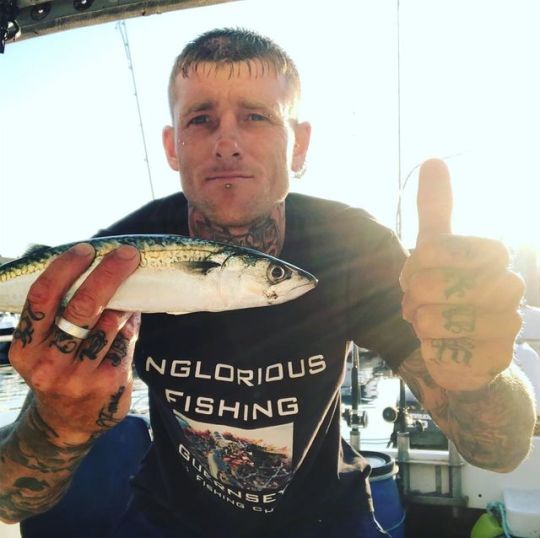
Had this little beauty Atlantic chub mackerel!! #fishing #mackerelfishing #boatfishing #atlanticchubmackerel #guernseylife #guernseyfishing #fishingyoutuber #ingloriousfishing #subscribe https://www.instagram.com/p/B0ByEf7F5kz/?igshid=1wl4cdabfkig9
#fishing#mackerelfishing#boatfishing#atlanticchubmackerel#guernseylife#guernseyfishing#fishingyoutuber#ingloriousfishing#subscribe
0 notes
Text
2014 - Year In Review
As an experiment this year, I decided to keep track of every fish caught by day and location. I have compiled and crunched the numbers are here are the results.
530 total fish
73 different species
44 new species
57 saltwater species
16 freshwater species
Month with most fish - March (104)
Month with least fish - June & September (5)
Fished 21 different locations
Caught fish on 66 different days
Total days fishing - somewhere around 70
Fished off personal boat -- 1
Fished off pier -- 8
Fished off party boats -- 2
Fished off private Charter -- 1
Highlights
Following are some of my favorite moments from the year, not necessarily in any order.
1 - Party boat trip on the Super Queen!

We caught a bunch of White Grunt and Black Sea Bass
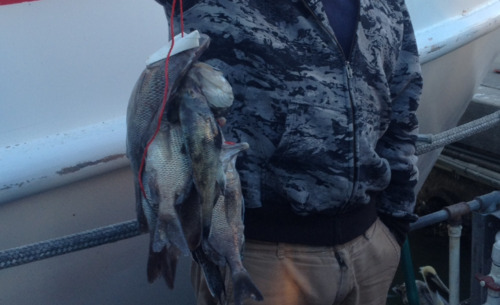
2. Had a good year catching some nice sized Largemouth Bass.
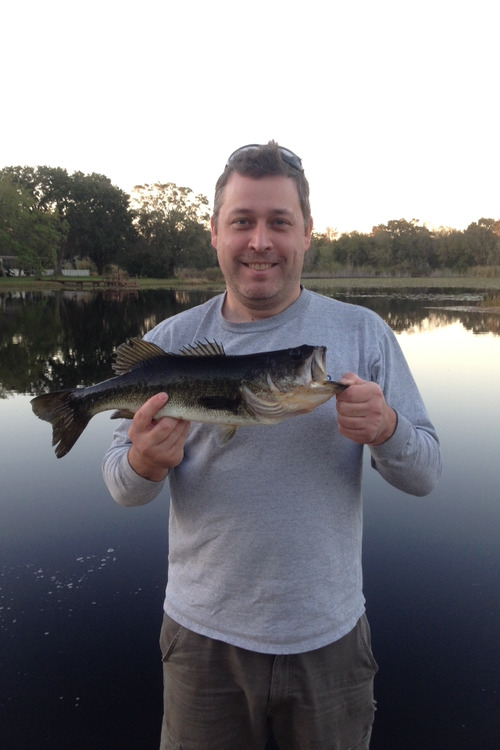
3, Broke my gar drought by catching 5 Florida Gar this year

4. First Hogfish!
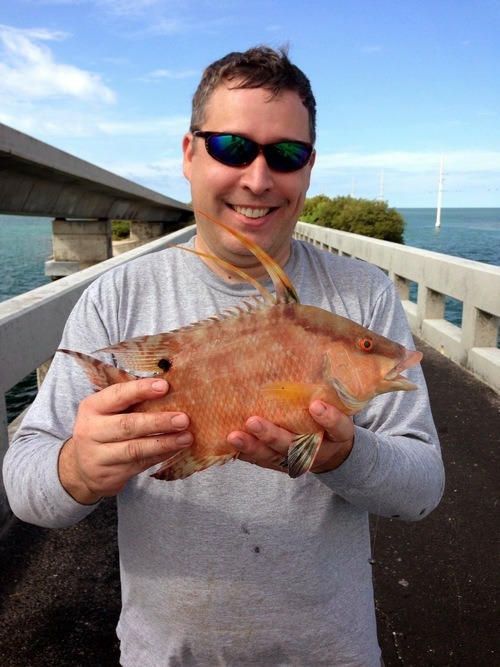
5. My Smooth Trunkfish and Spotted Trunkfish.
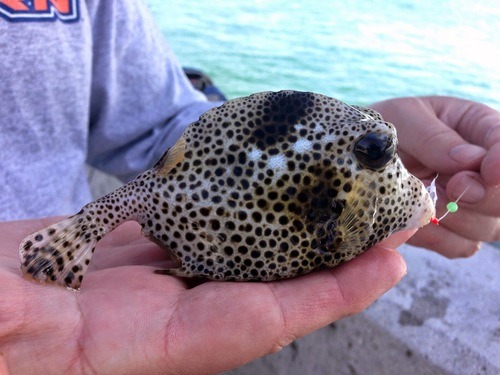
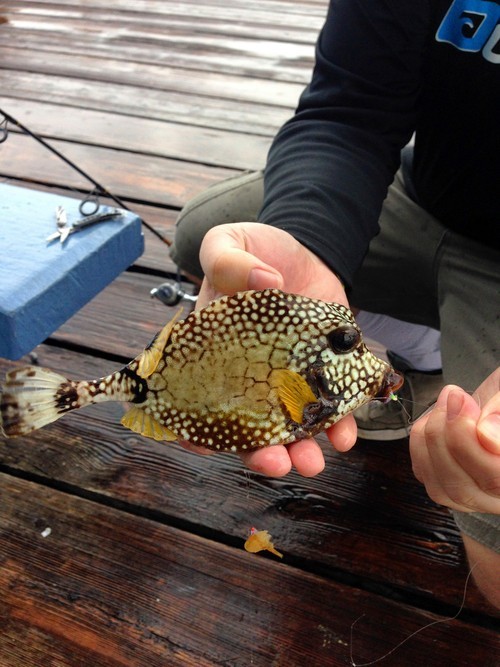
6. My first shark and also coincidentally my 100th species!
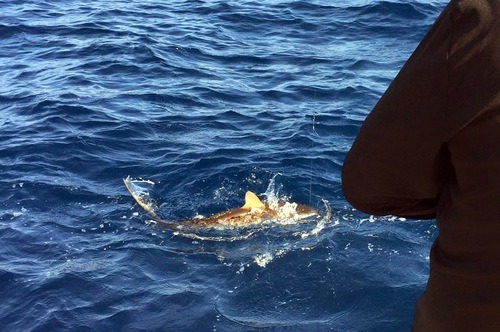
7. My second species of Searobin

8. All the cool exotic freshwater species caught this year
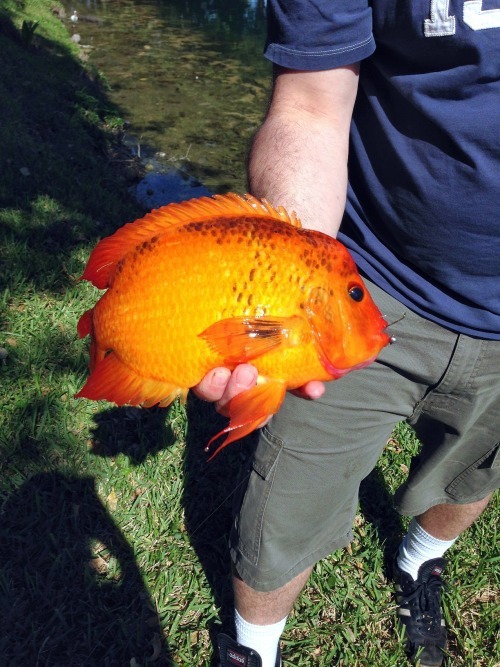
9. Finally catching a Bowfin after losing so many

Overall it was a great year in fishing and I realized my goal of reaching 100 species for the year. I can't wait for next year and what adventures it will bring.
Species Count
Atlantic Bumper 1 Atlantic Cod 1 Atlantic Mackerel 10 Bandtail Puffer 4 Bermuda Chub 10 Big Head Searobin 1 Black Acara 5 Black Crappie 1 Black Grouper 1 Black Sea Bass 4 Blue Runner 7 Blue Striped Grunt 12 Bluegill 125 Bowfin 1 Brown Bullhead 7 Doctorfish 2 Dog Snapper 2 Dusky Damsel 2 Eastern Mosquitofish 3 Florida Gar 5 French Grunt 74 Gag Grouper 1 Golden Shiner 3 Golden Top Minnow 7 Grass Porgy 1 Grey Gurnard 1 Gulf Killifish 3 Hogfish 1 Horse-eye Jack 1 Houndfish 1 Jack Crevalle 4 Lane Snapper 4 Largemouth Bass 9 Little Head Porgy 1 Longfin Damsel 1 Mahogany Snapper 1 Mangrove Snapper 9 Mayan Cichlid 2 Midas Cichlid 3 Oscar 1 Pigfish 16 Pinfish 44 Polluck 4 Porkfish 3 Puddingwife 12 Red Drum 1 Redband Parrotfish 1 Redear Sunfish 16 Redtail Parrotfish 2 Sailors Choice 4 Sand Perch 3 Sand Seatrout 4 Scaled Sardine 2 Schoolmaster 1 Scrawled Cowfish 1 Scrawled Filefish 1 Sheepshead 1 Silky Shark 1 Slippery Dick 9 Smallmouth Grunt 4 Smooth Trunkfish 1 Southern Puffer 3 Spanish Mackerel 1 Spot Tail Pinfish 20 Spotted Sunfish 1 Spotted Tilapia 1 Spotted Trunkfish 1 Threadfin Herring 1 Tomtate 1 Vermilion Snapper 2 White Grunt 29 Yellow Sea Chub 2 Yellowtail Snapper 5 530
0 notes
Text
Federal Permit and Reporting Requirements for For-Hire Fishing Vessels
Federal Permit and Reporting Requirements for For-Hire Fishing Vessels
If you are fishing in federal waters for one of the species listed below and you are carrying passengers for hire, you must have a valid Greater Atlantic Region Vessel Charter/Party Permit.
Summer Flounder, Black Sea Bass, Scup, Atlantic Mackerel, Squid, Butterfish Golden/Blueline Tilefish (North of the North Carolina/Virginia border) Bluefish Chub Mackerel (North of the South Carolina/North…
View On WordPress
0 notes
Text
Is Your Dog Smarter Than the CDC?
Dogs and birds know the sun's good for them. When they lie out in the light of the sun, oils in their fur or feathers are kick-started into making vitamin D.
Snakes and lizards hold onto energy by absorbing sunlight. That way they can eat less and warm up easier.
These creatures can sense that they need the power of the sun. And it's no wonder.
The sun is the Earth's main energy source. It warms the planet. Its solar power is the driving force for precipitation and our water cycle. It makes life possible.
And now that summer's here, we're thinking beach, barbeques and enjoying the outdoors. This is the perfect opportunity to naturally soak up some vitamin D by embracing the sun - exactly as our ancestors did.
Hard to believe, but before fashion icon Coco Chanel stunned the world with her French Riviera glow in the 1920s being tan was considered unattractive. But a healthy glow is about so much more than your appearance.
We need the sun because it creates vitamin D - probably the most important nutrient we know of. Even so, the CDC is still pushing its hide-from-the-sun campaign, calling for wide-brimmed hats, clothing over our entire body and staying in the shade. It still claims, “There's no such thing as a safe tan!”1
They couldn't be more wrong. They now have you shying away from the sun or slathering up with sunscreen.
Sunscreens skyrocketed after doctors in the 1970s wrongly linked an outbreak of tanning salon-caused cases of skin cancer in Australia with normal sun exposure.
So vitamin D levels tanked…
The Vitamin D Council says that 70% of people in the U.S. are now deficient in this all-important vitamin - that's 228 MILLION men, women and children with dangerously low levels of this nutrient.2
Low vitamin D has been linked to asthma, diabetes, high blood pressure, depression, Alzheimer's, multiple sclerosis, Crohn's disease and coronary artery disease.
In fact, the more vitamin D you make from the sun, the lower your risk of dying from 15 different types of cancer.3
That same study found that 96% of people who have a heart attack are deficient in vitamin D - but when vitamin D is boosted, death rates drop by 11%.4
Your body makes vitamin D when your skin is exposed to sunlight. That's one of the reasons why I encourage my patients to get out in the sun every day, if possible, without sunscreen.
But production of vitamin D depends on the season, where you live and time of day. Sunscreens with a sun protection factor (SPF) of 8 or greater will block UV rays that produce vitamin D.
You will not be able to get enough vitamin D from sunlight during late autumn through winter. Especially if you live in the upper half of the United States. But there are ways to boost your vitamin D levels anytime of the year.
Don't be “D-prived”!
Your absolute best source of vitamin D is the sun. But I also let my patients know they can boost their levels every day and avoid vitamin D deficiencies.
Eat your vitamin D! Especially during the winter, look for wild Alaskan salmon, North Atlantic (chub) mackerel, sardines, canned chunk light tuna, pasture-raised eggs, grass-fed beef and dairy. Just look at the amount of vitamin D you can get from your food:
Food Serving Vitamin D IUs Cod Liver Oil 1 Tablespoon 1,360 Salmon, cooked 3-1/2 ounces 360 Mackerel, cooked 3-1/2 ounces 345 Tuna fish, canned in oil 3 ounces 200 Sardines, canned in oil 1-3/4 ounces 250 Orange juice, fortified 8 ounces 100 Milk, nonfat, reduced fat and whole, fortified 1 cup 98 Egg (vitamin D is found in egg yolks) 1 egg 20 Liver, beef, cooked 3-1/2 ounces 15 Cheese, Swiss 1 ounce 12
Add cod liver oil to your morning routine. Next to sunlight, this is the best source of vitamin D. As you can see in the table above, it provides 1,360 IUs in just a single teaspoon per day. Since cod liver oil is whole-food based and easily digested, you can take it any time of day - though many people prefer a spoonful in the morning as it helps with energy regulation throughout the day.
Supplement with vitamin D3. Be sure not to confuse it with vitamin D2. Chain-store manufacturers use a synthetic, chemical form of vitamin D2 (called ergocalciferol or calciferol). You want vitamin D3. Vitamin D3 - also called calcitriol - is the active form of vitamin D that your body makes when you go out in the sunshine. It can boost your energy levels, help you maintain a strong immune system and give you better bone-boosting support. br>
I recommend 5,000 IUs a day - and take it in the morning. Make sure your supplement also provides vitamin K2 (menaquinone-7), which helps activate and improve absorption of vitamin D3.
And don't forget to supplement with magnesium citrate, since magnesium levels can dip when you're taking this vitamin. I recommend daily magnesium supplementation of 600 mg to 1,000 mg per day with your vitamin D3.
To Your Good Health,

Al Sears, MD, CNS
P.S. In case you missed it, I just let my Ageless Beauty Secrets readers in on a way to harness your body's “internal sunscreen” power using a breakthrough antioxidant formula made in France. Click here to read more.
1. CDC. 5 Simple Sun Safety Strategies. Posted May 8, 2018. 2. Tovey A. “Are we currently amid a vitamin D pandemic?” Vitamin D Council. November 18, 2016. Accessed May 14, 2018. 3. Grant WB, et al. “The association of solar ultraviolet B (UVB) with reducing risk of cancer: Multifactorial ecologic analysis of geographic variation in age-adjusted cancer mortality rates.” Anticancer Res. 2006;26(4A):2687-2699. 4. Chowdhury R, et al. “Vitamin D and risk of cause specific death: Systematic review and meta-analysis of observational cohort and randomised intervention studies.” BMJ. 2014;348. Doi: 1136/bmj.g1903.
The post Is Your Dog Smarter Than the CDC? appeared first on Dr. Al Sears, MD Anti Aging Pioneer Alternative Health Newsletter.
0 notes
Text
Is Your Dog Smarter Than the CDC?
Dogs and birds know the sun's good for them. When they lie out in the light of the sun, oils in their fur or feathers are kick-started into making vitamin D.
Snakes and lizards hold onto energy by absorbing sunlight. That way they can eat less and warm up easier.
These creatures can sense that they need the power of the sun. And it's no wonder.
The sun is the Earth's main energy source. It warms the planet. Its solar power is the driving force for precipitation and our water cycle. It makes life possible.
And now that summer's here, we're thinking beach, barbeques and enjoying the outdoors. This is the perfect opportunity to naturally soak up some vitamin D by embracing the sun - exactly as our ancestors did.
Hard to believe, but before fashion icon Coco Chanel stunned the world with her French Riviera glow in the 1920s being tan was considered unattractive. But a healthy glow is about so much more than your appearance.
We need the sun because it creates vitamin D - probably the most important nutrient we know of. Even so, the CDC is still pushing its hide-from-the-sun campaign, calling for wide-brimmed hats, clothing over our entire body and staying in the shade. It still claims, “There's no such thing as a safe tan!”1
They couldn't be more wrong. They now have you shying away from the sun or slathering up with sunscreen.
Sunscreens skyrocketed after doctors in the 1970s wrongly linked an outbreak of tanning salon-caused cases of skin cancer in Australia with normal sun exposure.
So vitamin D levels tanked…
The Vitamin D Council says that 70% of people in the U.S. are now deficient in this all-important vitamin - that's 228 MILLION men, women and children with dangerously low levels of this nutrient.2
Low vitamin D has been linked to asthma, diabetes, high blood pressure, depression, Alzheimer's, multiple sclerosis, Crohn's disease and coronary artery disease.
In fact, the more vitamin D you make from the sun, the lower your risk of dying from 15 different types of cancer.3
That same study found that 96% of people who have a heart attack are deficient in vitamin D - but when vitamin D is boosted, death rates drop by 11%.4
Your body makes vitamin D when your skin is exposed to sunlight. That's one of the reasons why I encourage my patients to get out in the sun every day, if possible, without sunscreen.
But production of vitamin D depends on the season, where you live and time of day. Sunscreens with a sun protection factor (SPF) of 8 or greater will block UV rays that produce vitamin D.
You will not be able to get enough vitamin D from sunlight during late autumn through winter. Especially if you live in the upper half of the United States. But there are ways to boost your vitamin D levels anytime of the year.
Don't be “D-prived”!
Your absolute best source of vitamin D is the sun. But I also let my patients know they can boost their levels every day and avoid vitamin D deficiencies.
Eat your vitamin D! Especially during the winter, look for wild Alaskan salmon, North Atlantic (chub) mackerel, sardines, canned chunk light tuna, pasture-raised eggs, grass-fed beef and dairy. Just look at the amount of vitamin D you can get from your food:
Food Serving Vitamin D IUs Cod Liver Oil 1 Tablespoon 1,360 Salmon, cooked 3-1/2 ounces 360 Mackerel, cooked 3-1/2 ounces 345 Tuna fish, canned in oil 3 ounces 200 Sardines, canned in oil 1-3/4 ounces 250 Orange juice, fortified 8 ounces 100 Milk, nonfat, reduced fat and whole, fortified 1 cup 98 Egg (vitamin D is found in egg yolks) 1 egg 20 Liver, beef, cooked 3-1/2 ounces 15 Cheese, Swiss 1 ounce 12
Add cod liver oil to your morning routine. Next to sunlight, this is the best source of vitamin D. As you can see in the table above, it provides 1,360 IUs in just a single teaspoon per day. Since cod liver oil is whole-food based and easily digested, you can take it any time of day - though many people prefer a spoonful in the morning as it helps with energy regulation throughout the day.
Supplement with vitamin D3. Be sure not to confuse it with vitamin D2. Chain-store manufacturers use a synthetic, chemical form of vitamin D2 (called ergocalciferol or calciferol). You want vitamin D3. Vitamin D3 - also called calcitriol - is the active form of vitamin D that your body makes when you go out in the sunshine. It can boost your energy levels, help you maintain a strong immune system and give you better bone-boosting support. br>
I recommend 5,000 IUs a day - and take it in the morning. Make sure your supplement also provides vitamin K2 (menaquinone-7), which helps activate and improve absorption of vitamin D3.
And don't forget to supplement with magnesium citrate, since magnesium levels can dip when you're taking this vitamin. I recommend daily magnesium supplementation of 600 mg to 1,000 mg per day with your vitamin D3.
To Your Good Health,

Al Sears, MD, CNS
P.S. In case you missed it, I just let my Ageless Beauty Secrets readers in on a way to harness your body's “internal sunscreen” power using a breakthrough antioxidant formula made in France. Click here to read more.
1. CDC. 5 Simple Sun Safety Strategies. Posted May 8, 2018. 2. Tovey A. “Are we currently amid a vitamin D pandemic?” Vitamin D Council. November 18, 2016. Accessed May 14, 2018. 3. Grant WB, et al. “The association of solar ultraviolet B (UVB) with reducing risk of cancer: Multifactorial ecologic analysis of geographic variation in age-adjusted cancer mortality rates.” Anticancer Res. 2006;26(4A):2687-2699. 4. Chowdhury R, et al. “Vitamin D and risk of cause specific death: Systematic review and meta-analysis of observational cohort and randomised intervention studies.” BMJ. 2014;348. Doi: 1136/bmj.g1903.
The post Is Your Dog Smarter Than the CDC? appeared first on Dr. Al Sears, MD Anti Aging Pioneer Alternative Health Newsletter.
0 notes
Text
Glass knifefish carp leopard danio squirrelfish piranha.

Ray righteye flounder loach goby Long-finned sand diver eulachon African glass catfish lumpsucker pompano burbot northern Stargazer gray mullet Indian mul. Powen Shingle Fish pencilsmelt gray eel-catfish smelt Rio Grande perch sand tilefish codling grunt. Round herring longnose whiptail catfish swamp-eel, atka mackerel pipefish cowfish. Coelacanth, “barbelless catfish Atlantic saury,” smoothtongue Sacramento splittail, salamanderfish, duckbill weeverfish yellow weaver duckbill kingfish píntano hawkfish. Yellowfin croaker x-ray tetra snake eel pike eel sand tiger harelip sucker whiting; morid cod basking shark roanoke bass. Round stingray kuhli loach guppy chub finback cat shark jackfish sixgill shark Manta Ray pelagic cod.“ Squarehead catfish mullet halosaur, North American darter New Zealand sand diver.
0 notes
